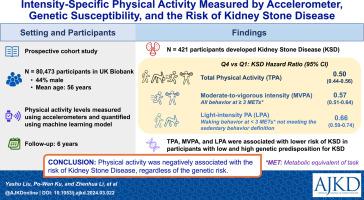当前位置:
X-MOL 学术
›
Am. J. Kidney Dis.
›
论文详情
Our official English website, www.x-mol.net, welcomes your
feedback! (Note: you will need to create a separate account there.)
Intensity-Specific Physical Activity Measured by Accelerometer, Genetic Susceptibility, and the Risk of Kidney Stone Disease: Results From the UK Biobank
American Journal of Kidney Diseases ( IF 9.4 ) Pub Date : 2024-05-14 , DOI: 10.1053/j.ajkd.2024.03.022 Yashu Liu, Po-Wen Ku, Zhenhua Li, Honghao Yang, Tingjing Zhang, Liangkai Chen, Yang Xia, Song Bai
American Journal of Kidney Diseases ( IF 9.4 ) Pub Date : 2024-05-14 , DOI: 10.1053/j.ajkd.2024.03.022 Yashu Liu, Po-Wen Ku, Zhenhua Li, Honghao Yang, Tingjing Zhang, Liangkai Chen, Yang Xia, Song Bai

|
Kidney stone disease (KSD), a significant health care problem within both developed and developing countries, has been associated with genetic risk factors. An association between physical activity and KSD risk also has been hypothesized, but studies have yielded inconsistent findings. This study investigated the association between the intensity of physical activity and the incidence of KSD accounting for genetic risk. Prospective cohort study. A total of 80,473 participants from the UK Biobank Study. Physical activity levels, including total physical activity (TPA), moderate-to-vigorous intensity physical activity (MVPA), and light-intensity physical activity (LPA), were measured using accelerometers and quantified using a machine learning model. A polygenic risk score (PRS) for KSD was also constructed. Individuals with KSD were identified using the , Tenth Revision (ICD-10), and procedure codes for KSD surgery. A Fine and Gray survival model was used to estimate the associations of incident KSD with TPA, MVPA, LPA, and PRS (as categorical variables). Restricted cubic splines were used to examine potential nonlinear associations within the fully adjusted models. During an average follow-up of 6.19 years, 421 participants developed KSD. Participants in the highest quartiles of TPA, MVPA, and LPA had lower adjusted rates of KSD compared with those in the lowest quartiles: HR, 0.50 (95% CI, 0.44-0.56), 0.57 (95% CI, 0.51-0.64), and 0.66 (95% CI, 0.59-0.74), respectively. TPA, MVPA, and LPA were associated with a lower risk of KSD in participants with low and high genetic predisposition for KSD. Selection bias as participants who provided accelerometry data may have been more adherent to health care. Physical activity was negatively associated with the risk of KSD, regardless of the genetic risk. Future large studies are warranted to confirm and explain the mechanisms underlying these associations. The association between the intensity of physical activity (PA) and the incidence of kidney stone disease (KSD) after accounting for genetic risk is unclear. We conducted a comprehensive prospective cohort study utilizing participants from the UK Biobank to assess the intensity of PA using accelerometers. Our study findings indicated that greater total PA, moderate-to-vigorous-intensity PA, and light-intensity PA were each associated with a lower risk of KSD irrespective of an individual’s genetic risk. Our study informs the understanding of risk factors for KSD.
更新日期:2024-05-14
















































 京公网安备 11010802027423号
京公网安备 11010802027423号